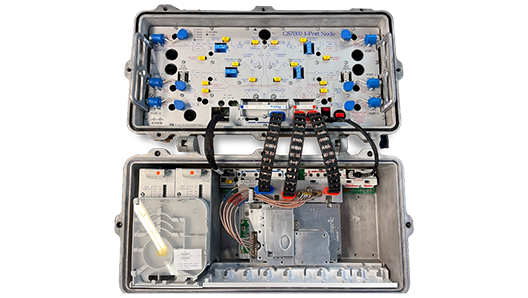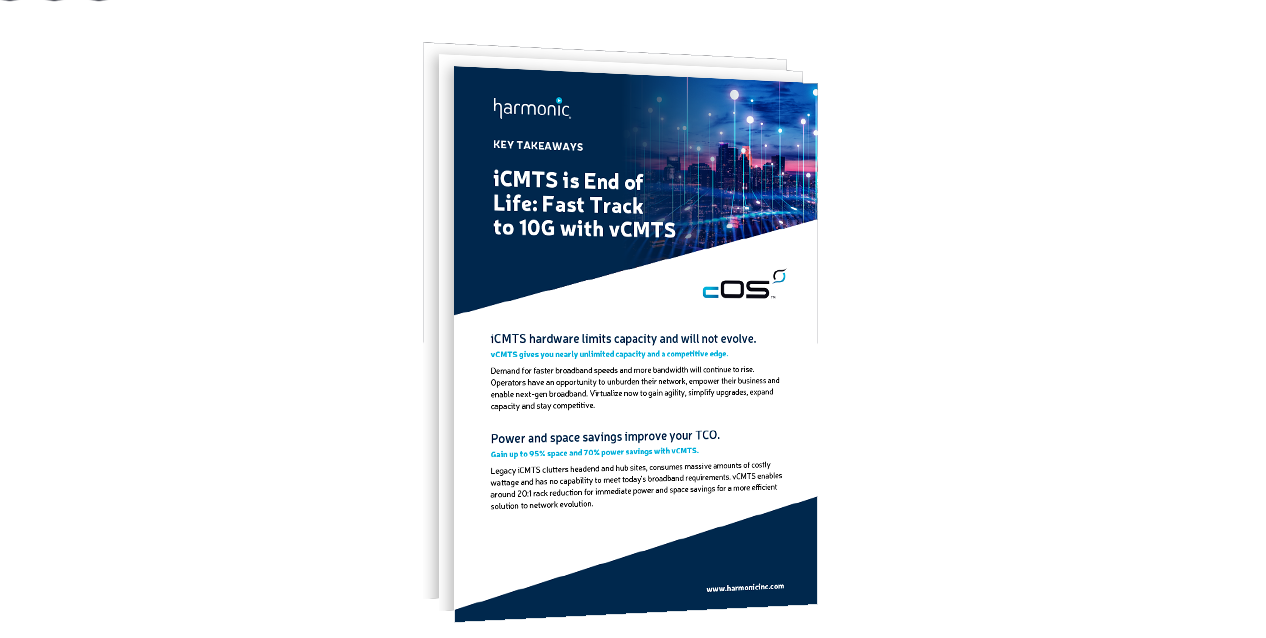The media industry is moving to All-IP infrastructures, and it’s a progressive process. Whether due to budget or workflow constraints, switching to all-IP overnight can pose challenges for many broadcasters.
However, Hybrid SDI and IP solutions help bridge the gap. Hybrid solutions let broadcasters keep a foot in both the SDI and IP environments until they’re ready to make the leap to a complete, all-IP infrastructure.
The step-by-step approach when moving to all-IP is common, and there are multiple advantages that are driving the shift:
- IT networking technology is more agile and flexible.
- An all-IP production and distribution infrastructure reduces costs over the long term.
- All-IP leverages more advanced features to boost efficiency relative to processing and bandwidth.
A Brief intro to All-IP
The delivery of compressed video signals over IP began more than a decade ago, and it continues to gain momentum in the broadcast environment even today. Over the last several years, major broadcast facilities have embraced IP networking infrastructures, including NBC Universal’s new Telemundo Center in Miami, CNN’s new headquarters at 30 Hudson Yards in New York and BBC Wales’ new facility in Cardiff. Based on the track record for adoption, it’s predicted that IP-based production will be universally implemented by 2025.
When you transition media workflows to all-IP, you’re essentially removing all non-IP connectivity. This process is not just limited to SDI. The move to all-IP workflows encompasses discrete audio cabling, GPI tie lines, USB, KVM and other cabling that does not connect through a network switch.
Ultimately, the main objective is to remove conversion equipment between SDI and IP. You’re replacing routing infrastructure with commercial-off-the-shelf (COTS) network switches and compute datacenters. A COTS network infrastructure is more cost-effective, easier to update and simpler to use.
Envisioning the migration path: How and why to move to All-IP
The road to all-IP isn’t as fast as launching a channel in the cloud. Hybrid infrastructures will be the norm for many broadcasters, and it’s likely that the hybrid approach will be used for a considerable period of time. There are two main reasons that transitioning to all-IP workflows rarely happens overnight. The first reason is straightforward — it can be costly.
Another reason why migrating to all-IP workflows is a multi-step process: Some workflows currently deployed are more convenient to deliver using SDI. These edge cases are becoming less and less common, as vendors work on removing them in their transition to more flexible IP infrastructures that provide agility to meet new video delivery demands.
All-IP workflows provide simplicity, flexibility and improved video quality
There are several motivating factors that make moving to IP attractive for the broadcast world.
The root benefit of IP is flexibility. You can send any source to any destination, over greater distances and do so in a way that makes the streams easier to work with using an IP infrastructure.
An excellent example of the simplicity that can be achieved with IP is how SMPTE ST 2110 enables video, audio and data to flow as separate streams over the IP network. You can select which streams are needed for a particular device in the workflow.
For example, a video server will necessitate all streams, while a graphics device only needs video. In this context, you don’t have to de-embed the video, audio and data. If using SDI you would have to de-embed and it would add complexity to the workflow.
Connecting multiple I/O devices is also easier with IP. A single network connection gives you access to multiple channels of input and output. SDI only supports one input or one output, per cable.
IP also makes plug-and-play possible, but we will get to that later on in this blog.
The power of COTS hardware for faster, cost-effective software deployment
Migrating to all-IP enables you to take advantage of COTS hardware, which is appealing for a few reasons. Right now, the industry needs flexible systems that rely on software rather than ASICs and FPGAs. COTS systems adapt on-the-fly for simple, instant upgrades and reduced management and maintenance. COTS hardware simplifies purchasing, warranties and SLAs as it reduces the number of vendors that you would have deal with. We all enjoy a simple one-stop-shop.
As video production and distribution may have a certain level of complexity, many are looking for ways to increase efficiency in their video delivery network. IP systems are easier to manage and maintain. Broadcasters also gain increased purchasing power for computing and networking when moving to IP.
- Cabling, bandwidth and density gains: Compared with SDI, all-IP workflows drastically reduce the amount of cabling, equipment, bandwidth and power required for broadcast delivery. IP supports much higher resolutions with greater bit depth than SDI. Many signals can be carried on a single connection in both directions compared to just one signal in one direction with SDI. With IP workflows, video, audio and data can be handled separately, and if needed, without the hassle of de-embedding and re-embedding.
- Plug and play simplicity: With IP, there’s an opportunity to make IP-based systems plug and play. Plug-and-play systems describe the sources and destinations available, taking the guesswork out of routing tables, matching resolutions and knowing whether a source or destination is present or not. When you get a new or upgraded device, all you have to do is turn it on and it’s instantly found on the network. If the device fails or is taken out of service, control systems automatically know it is no longer available. This simplifies installation and expansion of IP systems.
- IP economics: Function integration — the ability to combine previously discrete functions on a single platform — is helping drive the migration to IP. In the IP world you can use one software-based platform for multiple media processing tasks, which increases savings.
While the cost to upgrade to all-IP is a factor, longer-term cost implications make IP more attractive than SDI. IP currently favors larger deployments, but IT economics will make IP technologies more accessible for simpler, smaller scale deployments over time.
Hybrid solutions ensure a smooth migration
Today, you’ll find products on the market focused on enabling the conversion between SDI and IP. Other solutions are designed to support SDI and IP simultaneously. Hybrid solutions exist to make the migration to IP more approachable and easier to tackle. By deploying IP-enabled solutions bit by bit, you can be assured that when the time comes, making the full transition to IP will be relatively simple. This situation is similar to the shift that happened with HD resolutions. More than a decade ago, broadcasters began purchasing HD-enabled products even though they weren’t fully on-air with HD channels. This ensured an easier to switch from SD to HD.
The endgame is to leverage software and IT networking to solve more and more of broadcast workflow needs. Hardware touch points will still be needed for certain applications, such as control panels and other user interfaces. However, there will be a bounty of benefits thanks to using more compute-based systems to create practical, highly responsive end-to-end solutions.
Most systems today are already IP-based, including editing, transcoding, encoding, and delivery systems. The real-time workflows tied to SDI are the last major holdout for proprietary connectivity.
IP infrastructure technologies and your next steps
IT technologies are advancing at a rate much faster than the proprietary connectivity of SDI. In the future, IT will become more prevalent for broadcast applications.
Now that IP is being adopted at the transport layer, a huge focus in the industry is on increasing ease of use. The idea is to create the broadcast network-equivalent of plugging in USB devices into a laptop. Devices plug in and just work. This too is a big leap forward over the manual configuration requirements that SDI poses.
While the momentum for all-IP continues to accelerate, adoption of cloud technology is also increasing across the broadcast environment. The fastest and easiest way to the cloud is through IT and IP. Whether the cloud system exists on-premises or in the public cloud, IP connectivity is key to enabling a seamless connection between the production and broadcast worlds. The cloud has emerged as a key factor in video service delivery and has proved to be considerably reliable in times when video traffic is surging. The cloud is the best way to maintain service continuity, and all-IP plays a major role.
Harmonic is bridging IP and SDI worlds
Harmonic is driving the migration to all-IP delivery with hybrid IP and SDI solutions. Want to find out more about how our all-IP solution can increase the efficiency, scalability and cost savings of your media operations? Contact us today to start a conversation on your migration to all-IP for video processing and delivery.










